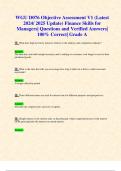Exam (elaborations)
Solution Manual for Fundamentals of Investments Valuation and Management, 10th Edition by Bradford Jordan, Thomas Miller and Steve Dolvin
Solution Manual for Fundamentals of Investments Valuation and Management, 10th Edition by Bradford Jordan, Thomas Miller and Steve Dolvin. PART ONE: INTRODUCTION Chapter 1: A Brief History of Risk and Return Chapter 2: The Investment Process Chapter 3: Overview of Security Types Chapter 4: Mutual F...
[Show more]












